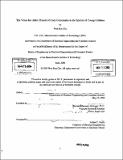The voice-bar after closure of coda consonants in the speech of young children
Author(s)
Cho, Won Ron
DownloadFull printable version (36.50Mb)
Other Contributors
Massachusetts Institute of Technology. Dept. of Electrical Engineering and Computer Science.
Advisor
Stefanie Shattuck-Hufnagel.
Terms of use
Metadata
Show full item recordAbstract
The purpose of this study is to gain some insight into the speech acquisition process and articulator development of young children whose mother-tongue is American English. The presence of voice-bars after the closure of voiceless coda consonants in consonant-final words from early child speech is not consistent with the idea that voice-bars are important for distinguishing voiced consonants from voiceless consonants. This study examined this potential deviation from the adult speech model and asked whether children become better at producing voice-bars after the appropriate set of voiced consonants as they become older. The consonant final words chosen for this study are bug, cup, duck, and tub, in recordings of the speech of 5 children (ages 2;6-3;2). The recordings were taken over the period of 6 months. The results show that the children do become better at producing voice-bars after the selected set of voiced consonants as they become older. This voice-bar production pattern suggests that these children at some point have realized that voice-bars are important for distinguishing voiced consonants from voiceless consonants.
Description
Includes bibliographical references (p. 50-53). Thesis (M. Eng.)--Massachusetts Institute of Technology, Dept. of Electrical Engineering and Computer Science, 2008.
Date issued
2008Department
Massachusetts Institute of Technology. Department of Electrical Engineering and Computer SciencePublisher
Massachusetts Institute of Technology
Keywords
Electrical Engineering and Computer Science.